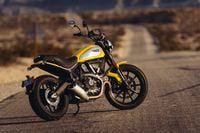Every generation has its Brando moment, the spark that ignites a desire to explore life on two wheels. Be it movie, idol, or iconic motorcycle, it’s usually more about lifestyle than machine. For me, it was a fellow, tatted-up waitress in my college years who was building an old basketcase BSA. I never even got to see her ride it; I just wanted to be that badass girl with dirt under my nails.
The newest generation of riders has a heavy vintage influence and a penchant for—you guessed it—the café racer. They love the classic styling and mechanical simplicity of the bikes, and all the stylish apparel that goes with it. But the trouble with those vintage machines is that they're finicky, unpredictable, and often broken. Which is why Ducati has chosen this moment to re-launch the Scrambler, a retro yet reliable bike for the vintage enthusiast.
Today’s Scrambler wraps vintage-inspired styling around modern technology—but not too modern, for simplicity is key to the “post-heritage” experience. The first Scrambler was a simple, fun, multi-purpose bike, distilling the essence of motorcycling down to two knobby-covered wheels and a motor. Ducati aims to recapture that unfettered spirit of the ‘60s via the new Scrambler, complete with a catalog of bolt-on accessories and a line of apparel. After all, it’s not a motorcycle, it’s a lifestyle. To woo self-ironic hipsters and other trendsetters, however, the company must walk a fine line between authenticity and marketing.
The Scrambler is available in four versions, each with a distinct logo and paint color, and attributes for different audiences. They share some key design features, retro mixed with modern: the teardrop-shaped tank, a tribute to the original model; the classic round headlight, rimmed with an LED ring; a single, round instrument panel positioned to the right, with full digital display; and a single-disc front brake with a radial-mounted, four-piston caliper. Each model can be personalized with any of the custom accessories (my favorite: plaid tank covers). For the press launch, we tested the Icon model on winding mountain roads near Idyllwild in Southern California.
True to the Scrambler’s minimalist roots, the air-cooled engine and cable-actuated clutch help keep the design clean while providing a visceral mechanical feel. Get on the gas, and the compact muffler emits a satisfying growl. The clutch lever pull was lighter than I expected, though working the shift pedal took some effort. All part of the authentic vintage experience, I guess, since every gear shift provided a rewarding thunk.
Initially, I had a hard time with the abrupt throttle response in first gear, which awkwardly launched the bike forward a few times much more rapidly than I expected. (And, no, there are no ride modes to adjust.) Combine this characteristic with fairly stiff suspension and the ride can be a little jerky in city traffic. Short-shifting took the edge off (i.e., I got the hell out of first gear, fast). I’m wondering whether new riders will struggle with the abrupt throttle, though we might attribute some of the jerkiness to the fact that my bike wasn’t warmed up when it happened.
Throttle response wasn’t an issue at higher speeds, partly because the motor’s abundant torque minimizes the amount of downshifting needed. The Scrambler’s 803cc V-twin engine delivers plenty of power for both highways and byways, and the six-speed gearbox allows for relaxed cruising at freeway speeds.
Thanks to its light weight, wide bars, and neutral handling, the Scrambler is incredibly fun to weave along twisty roads and docile in slow-speed maneuvers (the bane of newbies!). The upright seating position made me feel like a rider from decades ago, somehow evoking the purest, simplest joy of motorcycling. The tank was a perfect shape for gripping with my knees, and the overall ergos were comfortably relaxed. Thanks to the narrow seat, one of my fellow journalists, a 5-foot-2 woman, had no trouble getting her feet on the ground from the bike’s 31.1-inch perch.
I liked the handling provided by the stiffer suspension, but it was slightly harsh on uneven pavement. At the same time, the Scrambler’s pseudo-knobbies and steady handling gave me confidence on a few pebble-covered stretches of road (which is saying a lot, as I’m a nervous off-road rider). The single-disc front brake does an excellent job of stopping the bike, with good feel and just enough bite. ABS is standard.
In the end, this bike will likely be judged for what it represents, less how it performs. It’s cool to look at and fun to ride, and in contrast to the size and complexity of many new bikes, the Scrambler takes a welcome detour back to the basics. What remains to be seen is whether the cool kids will buy into it. Some of those who ride clapped-out old bikes wear their authentic vintage experience like a badge of honor, if not as a testament to how cheaply they can live. Ducati’s best bet is selling the “post-heritage” experience to those who ride bikes like the modern Triumph Bonneville and Moto Guzzi V7. They’re much more likely to go for a shiny new motorcycle with monthly payments, especially when the price starts at a reasonable $8,495.





















/cloudfront-us-east-1.images.arcpublishing.com/octane/2WF3SCE3NFBQXLDNJM7KMXA45E.jpg)
/cloudfront-us-east-1.images.arcpublishing.com/octane/G4MG6OUCJNBSHIS2MVVOTPX65E.jpg)
/cloudfront-us-east-1.images.arcpublishing.com/octane/IIGGWFOTOJGB7DB6DGBXCCMTDY.jpg)
/cloudfront-us-east-1.images.arcpublishing.com/octane/QSTCM6AVEZA5JJBUXNIQ3DSOF4.jpg)
/cloudfront-us-east-1.images.arcpublishing.com/octane/U4I7G625B5DMLF2DVIJDFZVV6M.jpg)
/cloudfront-us-east-1.images.arcpublishing.com/octane/B6XD6LS6IVCQPIU6HXDJSM3FHY.jpg)
/cloudfront-us-east-1.images.arcpublishing.com/octane/ICL63FEDDRDTTMINYICCEYGMDA.jpg)
/cloudfront-us-east-1.images.arcpublishing.com/octane/FCGZHQXRBZFLBAPC5SDIQLVF4I.jpg)
/cloudfront-us-east-1.images.arcpublishing.com/octane/WNOB6LDOIFFHJKPSVIWDYUGOPM.jpg)

/cloudfront-us-east-1.images.arcpublishing.com/octane/X33NU3E525ECRHXLNUJN2FTRKI.jpg)
/cloudfront-us-east-1.images.arcpublishing.com/octane/6KKT5NNL2JAVBOXMZYS5ZO76YA.jpg)
/cloudfront-us-east-1.images.arcpublishing.com/octane/J5RKG5O455GMPGQRF2OG6LRT7A.jpg)
/cloudfront-us-east-1.images.arcpublishing.com/octane/GX2CIZKQVRH2TATDM26KFG2DAE.jpg)
/cloudfront-us-east-1.images.arcpublishing.com/octane/ZWIDYSAKQZHD5BHREMQILXJCGM.jpg)
/cloudfront-us-east-1.images.arcpublishing.com/octane/CYUHJZCTSJCH3MRAQEIKXK7SCQ.jpg)
/cloudfront-us-east-1.images.arcpublishing.com/octane/LKOFINY56FCXJCANJ5M7ZDQUBY.jpg)
/cloudfront-us-east-1.images.arcpublishing.com/octane/4NBPDACMWJH63JQYJVK3QRBDZI.jpg)
/cloudfront-us-east-1.images.arcpublishing.com/octane/KKHQHRR3FJGX7H2IPU6RALMWG4.jpg)

/cloudfront-us-east-1.images.arcpublishing.com/octane/5IOFS5JAE5FOXMNA23ZRAVVYUU.jpg)
/cloudfront-us-east-1.images.arcpublishing.com/octane/CGXQ3O2VVJF7PGTYR3QICTLDLM.jpg)

/cloudfront-us-east-1.images.arcpublishing.com/octane/OQVCJOABCFC5NBEF2KIGRCV3XA.jpg)